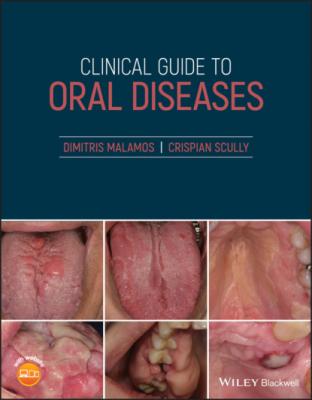Clinical Guide to Oral Diseases. Crispian Scully
Читать онлайн.| Название | Clinical Guide to Oral Diseases |
|---|---|
| Автор произведения | Crispian Scully |
| Жанр | Медицина |
| Серия | |
| Издательство | Медицина |
| Год выпуска | 0 |
| isbn | 9781119328155 |
Q2 Which other factors apart from urea can participate in fishy breath among patients with chronic kidney diseases (CKDs)?
1 Reduced flow rate
2 Type of dialysis treatment
3 Duration (acute vs. chronic)
4 Poor oral hygiene status
5 Electrolyte imbalance
Answers:
1 Reduced salivary flow rate (stimulated and unstimulated) is often found in CKDs. This hyposalivation allows the accumulation of sulfur producing bacteria within the mouth that are capable of producing urea, the basic component of fish odor.
2 No
3 No
4 Poor oral hygiene allows the accumulation of a number of bacteria, alters the pH of the biofilm matrix and causes tooth decay and gingival disease. All of these factors play an indirect role in halitosis production.
5 No
Comments: Halitosis is related to the severity and not to the duration or type of dialysis (peritoneal vs. hemodialysis). Electrolyte imbalance is a common finding but does not seem to play a role in halitosis.
Q3 Which is/or are the main component(s) of fish malodor?
1 Ketones
2 Cholines
3 Methylamines
4 Acetone
5 Carbon dioxide
Answers:
1 No
2 No
3 Methylamines (mono, di, or tri) are considered as the major components of uremic toxins which are poorly removed with dialysis and play an important role in the production of fish odor.
4 No
5 No
Comments: Acetone and other ketones are products of fatty metabolism in patients with uncontrolled diabetes where the metabolism of glucose is impaired due to low insulin synthesis. Carbon dioxide is the major gas component of exhaled air and altered in various conditions or diseases but has never been linked with fish odor.
Case 4.4
CO: A 23‐year‐old man presented with painful gums and bad breath.
HPC: His gums had been sore over the last ten days and associated with sialorrhea, metallic taste and bad breath.
PMH: This man had no serious medical problems, but his diet was inadequate and poor in proteins and fresh vegetables/fruits. He had lost his job last year and since then started to smoke more than 30 cigarettes daily.
OE: Erythematous gingivae with necrotic interdental papillae covered with whitish slough (Figure 4.4). The gingivae were sore on probing and associated with sialorrhea, metallic taste and bad fecal breath. No other lesions were found in his mouth and other mucosae apart from a mild cervical (sub‐mental/maxillary) lymphadenitis.
Q1 What is the cause of his bad breath?
1 Smoking
2 Chronic gingivitis
3 Acute necrotizing gingivitis
4 Malnutrition
5 Plasma cell gingivitis
Answers:
1 No
2 No
3 Acute necrotizing gingivitis is the cause of this condition, and is characterized by painful gums and inter‐dental papillae necrosis, both being associated with metallic taste and halitosis.
4 No
5 No
Comments: Oral malodor in young patients can be chronic or acute and seems to be related to local causes rather than systemic diseases. Among the local causes, oral infections and particularly of gingivae (gingivitis) and throat (pharyngitis); neglected mouth due to poor OH or bad habits like smoking, drinking and excessive diet are included. Some but not all the types of gingivitis have been associated with halitosis. Plasma cell gingivitis is characterized by accumulation of mature plasma cells in the free and attached gingivae, but is not associated with interdental necrosis or halitosis. Chronic gingivitis and smoking are often associated with chronic and not with acute halitosis as seen in this man; therefore are easily excluded. Malnutrition causes degradation of fat and release of ketones which are responsible for halitosis as long as the malnutrition lasts. His poor diet was recorded since the day of his job loss and is therefore is not a recent cause of halitosis.
Q2 Which other conditions are associated with this gingival condition?
1 Diabetes, mild
2 Drug (heroin) addiction
3 HIV‐AIDS +ve
4 Vitamin deficiency
5 Respiratory diseases
Answers:
1 No
2 Patients addicted to heroin and other drugs have neglected oral hygiene, which is the main predisposition factor for the development of acute necrotizing gingivitis (ANG).
3 Immunodeficiencies caused by HIV viruses are often associated with a number of oral conditions including ANG, especially when the number of circulated CD4 lymphocyte count is lower than 200 cells/μL in their bloods.
4 Deficiency of various vitamins, especially B12 and C due to malnutrition seems to play an important role in ANG and other periodontal diseases by affecting DNA synthesis, cellular maturation and immunity.
5 No
Comments: Although smoking is a causative factor for both respiratory and periodontal diseases including ANG, ANG tends to appear among younger patients with poor oral hygiene or uncontrolled severe diabetes mellitus or with psychological stress and immune‐suppression. Chronic respiratory diseases affect older patients, are progressive and can jeopardize the patient's life but not provoke the development of this type of gingivitis.
Q3 The microbiota pathogens of ANUG are:
1 Treponema spp.
2 Fusobacterium spp.
3 Selenomonas spp.
4 Streptococcus viridans
5 Lactobacillus acidophilus
Answers:
1 Treponema species are a group of spiral‐shaped bacteria that play a role in the pathogenesis of several diseases including syphilis (Trep. pallidum); periodontal and pulp diseases (Trep. denticole and Trep. lecithinolyticum).
2 Fusobacteria are anaerobic Gram –ve, non‐spurring, rod‐shaped bacilli, inhabitants of the oropharynx which cause several human diseases such as ANG and other periodontal diseases, skin atypical ulcerations and thrombophlebitis (Lemierre syndrome).
3 Selenomonas are anaerobic, Gram –ve, curved or crescent‐shaped rods that are isolated mainly from human oral cavity and play a crucial role in ANUG and other periodontal diseases.
4 No
5 No
